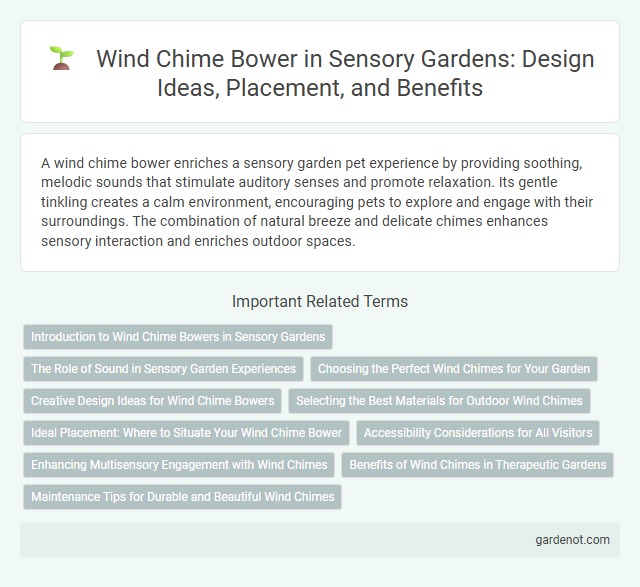A wind chime bower enriches a sensory garden pet experience by providing soothing, melodic sounds that stimulate auditory senses and promote relaxation. Its gentle tinkling creates a calm environment, encouraging pets to explore and engage with their surroundings. The combination of natural breeze and delicate chimes enhances sensory interaction and enriches outdoor spaces.
Introduction to Wind Chime Bowers in Sensory Gardens
Wind chime bowers in sensory gardens create immersive auditory experiences by incorporating a variety of chimes that respond to gentle breezes. These structures enhance sensory stimulation, promote relaxation, and support mindfulness through natural soundscapes. Positioning wind chime bowers near seating areas maximizes accessibility and engagement for visitors seeking calming sensory interaction.
The Role of Sound in Sensory Garden Experiences
Wind chime bowers enhance sensory garden experiences by introducing soothing auditory stimuli that promote relaxation and mindfulness. The varied tones and rhythms of wind chimes stimulate auditory senses, aiding cognitive function and emotional well-being in therapeutic garden settings. Integrating wind chime soundscapes supports sensory engagement, making environments inclusive for visitors with diverse sensory processing needs.
Choosing the Perfect Wind Chimes for Your Garden
Selecting the perfect wind chimes for your sensory garden involves considering materials such as aluminum for a clear, melodic tone or bamboo for a softer, natural sound that complements the outdoor environment. Size and length impact the pitch and volume, so opt for longer tubes for deeper tones and shorter ones for higher notes that gently enhance the garden's ambiance. Placement within the wind chime bower should ensure exposure to gentle breezes, maximizing soothing auditory stimulation while blending harmoniously with surrounding plants and textures.
Creative Design Ideas for Wind Chime Bowers
Incorporate recycled materials such as bamboo, seashells, and glass to craft unique wind chime bowers that enhance the sensory garden's auditory and visual appeal. Use varying lengths and thicknesses of chime components to create harmonious, layered sounds that respond to gentle breezes. Position the bower near fragrant plants or water features to enrich the immersive sensory experience with complementary natural elements.
Selecting the Best Materials for Outdoor Wind Chimes
Choosing durable materials like teak, cedar, or iroko wood ensures longevity and natural beauty for outdoor wind chimes, while aluminum and copper offer corrosion resistance and pleasant tones. Weather-resistant finishes protect the wind chime bower from moisture, UV rays, and temperature fluctuations, maintaining structural integrity and sound quality. Combining these materials with sturdy mounting hardware guarantees stability and enhances the sensory garden experience through soothing, consistent chime sounds.
Ideal Placement: Where to Situate Your Wind Chime Bower
Position your wind chime bower in a sheltered yet open area of the sensory garden where gentle breezes can activate the chimes without overwhelming strong winds. Opt for a location near seating or walking paths to enhance auditory experiences while ensuring the structure benefits from partial shade to protect the chimes' materials. Placing it adjacent to fragrant plants or water features maximizes sensory interactions, enriching the overall garden ambiance.
Accessibility Considerations for All Visitors
The Wind Chime Bower in the sensory garden is designed with accessibility features such as wide, smooth pathways and adjustable-height chimes to accommodate visitors with mobility challenges and wheelchair users. Tactile markers and Braille signage guide visually impaired guests, enhancing independent exploration. Sound-sensitive elements ensure that all visitors, including those with sensory processing differences, can engage comfortably and enjoy the interactive auditory experience.
Enhancing Multisensory Engagement with Wind Chimes
The Wind Chime Bower in a sensory garden creates a dynamic auditory experience that enhances multisensory engagement by producing soothing, natural sounds with every breeze. Strategically placed wind chimes of varied materials and tones stimulate auditory perception and promote relaxation, while their gentle movement invites tactile and visual interaction. This harmonious blend of sound, sight, and touch supports sensory integration and emotional well-being in garden visitors.
Benefits of Wind Chimes in Therapeutic Gardens
Wind chimes in therapeutic gardens promote relaxation by producing soothing, melodic sounds that reduce stress and anxiety. Their gentle tones enhance sensory stimulation and encourage mindfulness, aiding in emotional well-being and cognitive function. The rhythmic chiming supports a calming atmosphere, making wind chime bowers essential elements in sensory garden design for therapy and healing.
Maintenance Tips for Durable and Beautiful Wind Chimes
Regularly clean wind chimes with a soft cloth and mild soap to prevent dirt buildup and maintain their vibrant appearance in the sensory garden. Inspect hanging cords and metal tubes for signs of wear or corrosion, replacing damaged parts promptly to ensure durability and clear sound quality. Applying a protective sealant to wooden components helps resist weather damage, prolonging the beauty and functionality of the wind chime bower.
Wind chime bower Infographic

 gardenot.com
gardenot.com